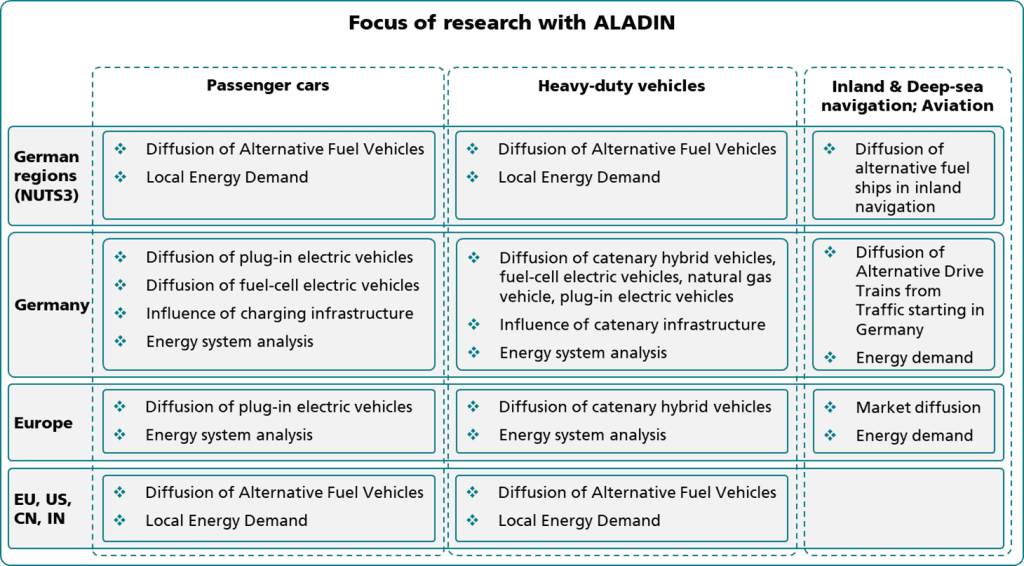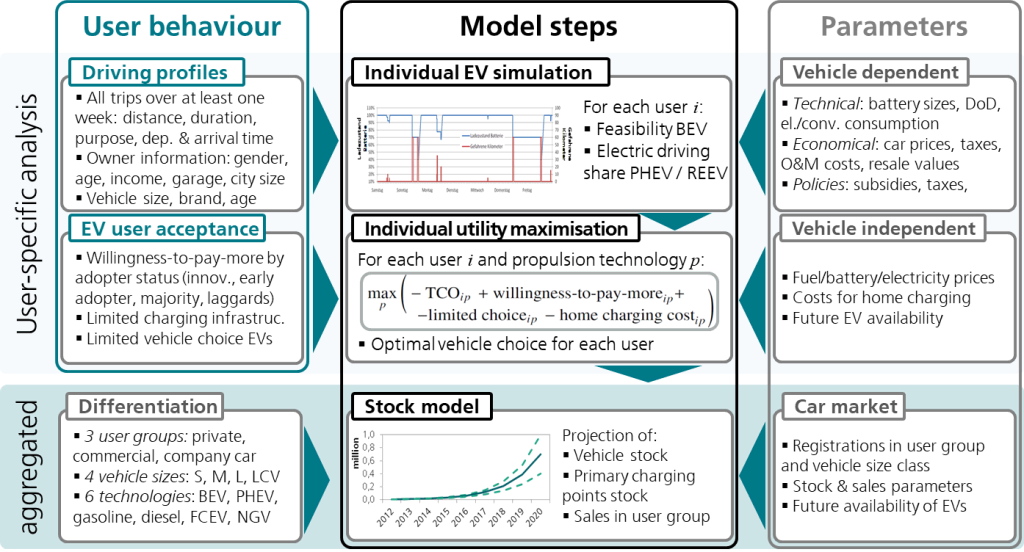The ALADIN – Alternative Automobiles Diffusion and INfrastructure – model is an agent-based simulation model that determines the market diffusion of alternative drivetrains for passenger cars, trucks, buses, airplanes, and ships. The core of the model is to calculate the total cost of ownership for different drivetrains (e. g. gasoline, diesel, battery electric, plug-in hybrid electric, hydrogen) based on large datasets for individual user driving data [MOP 2010, Fraunhofer ISI 2014, KiD 2010, Truckscout 2016] and to determine the utility maximizing driving option under various restrictions including limited infrastructure or limited model availability of new drivetrain technologies. Thereof, the share of each drivetrain technology is calculated, reduced due to infrastructure and limited vehicle availability and then considered as market share for the year under consideration [Plötz et al. 2014, Gnann 2015, Wietschel et al. 2017].
The model covers 2020 to 2050 in annual resolution. For Germany, a spatial resolution on NUTS3-level is available. NUTS3-level corresponds to 294 districts and 107 independent cities. Simplified model variants enable market diffusion calculations for Europe, China, the United States of America, and India on a world region level and for EU27+3 on a country level. Moreover, charging load profiles and the availability of vehicles at the grid can be extracted for passenger cars, e.g. for load shifting and vehicle-to-grid analyses [Gnann et al, 2018].
The model results include vehicle registrations, vehicle stock, the final energy demand by the energy carrier, and CO2 emissions.
Figure 1 provides an overview of the dimensions taken into account in ALADIN.

Basically, the model uses three different types of input parameters: (1) data on user behavior, (2) vehicle parameters and technical trends, and (3) forecasts on the future vehicle market. As mentioned earlier, the data on user behavior includes driving profiles. However, the data on user behavior also includes the willingness to pay more or less for alternative drivetrains, i.e. the attitude towards alternative drivetrains, and the willingness to change the vehicle brand, if necessary. Vehicle parameters include technical data – e.g. consumption or vehicle range – and economical parameters – e.g. vehicle prices, taxes, or costs for operation and maintenance. Finally, forecasts on the future total vehicle market – vehicles sales and vehicle stock – are needed. ALADIN is therefore often used in combination with the ASTRA model, which calculates the modal split, a possible future vehicle fleet, and the total mileage based on macroeconomic parameters, such as population and GDP (see above). Additionally, the future vehicle market also includes assumptions about available models and drivetrains, which must be specified exogenously.
End-use technologies
For passenger cars, the model covers gasoline vehicles, diesel vehicles, gas vehicles, plug-in hybrid electric vehicles, battery electric vehicles, and fuel cell electric vehicles.
Vehicles are differentiated into three sizes – small, medium, large -, and ALADIN distinguishes three purposes of use: private vehicles, fleet vehicles, and company cars.
For commercial vehicles, ALADIN considers up to five size categories: 0-3.5 t gross vehicle weight, 3.5-7.5 t gross vehicle weight, 7.5-12 t gross vehicle weight, > 12 t gross vehicle weight, and tractor-trailer trucks. Diesel vehicles, gas vehicles, plug-in hybrid vehicles, battery electric vehicles (short range and long range), overhead catenary diesel hybrid vehicles, overhead catenary battery electric vehicles, and fuel cell electric vehicles are considered as possible drivetrains.
Policy instruments / measures
Policy measures can be implemented in ALADIN in different ways. Policy measures that have a direct monetary impact on the vehicle purchase decision or the vehicle use can be integrated directly, e.g. purchase premiums, penalty payments, tax reductions, or a CO2 tax (compare [Cao Van et al. 2023]). Other measures, such as emission reduction targets for new vehicles, but also sales bans for combustion engines, have an influence on the vehicle availability modeled in ALADIN. Finally, measures relating to the expansion of infrastructure – charging facilities and refueling stations – influence the technical feasibility of battery electric vehicles and fuel cell electric vehicles.
Methods and model framework
The ALADIN model uses a three-step procedure to analyze the future market diffusion of alternative drivetrains: (1) individual EV simulation, (2) individual utility maximization, and (3) stock model. As a first step, simulates several thousand driving profiles as battery-electric and plug-in hybrid electric vehicles. Taking into account technical framework parameters, ALADIN determines the battery electric feasibility of a battery electric vehicle and the electric driving share of a plug-in hybrid. Secondly, a function determines the utility for each technically possible drivetrain, considering capital expenditures and operational expenditures, but also soft factors, such as willingness to pay more for an electric vehicle or brand loyalty. Thirdly, vehicle sales by drivetrain technology are calculated. Each single driving profile represents several vehicle buyers. If possible, the drivetrain with the highest utility is selected. However, the vehicle sales also consider a limited offer of vehicle models and a limited infrastructure. Due to a lack of suitable models and – in early years – charging or refueling locations for alternative drivetrains, partly second- or third-best options are selected. The sales figures are integrated into a stock model. More details are given in [Cao Van et al. 2023] and [Gnann et al. 2022]. As an example, Figure 2 shows the procedure for passenger cars. The approach for commercial vehicles is similar, yet contains user group specific assumptions.

The market diffusion of trucks is modeled similarly to passenger cars, yet the utility maximization is completely determined by the total cost of ownership of the vehicle. An overview of this model part is shown in Figure 3.

All exogenous data and parameters used are also shown in Figures 2 and 3.
The final energy demand of aviation, navigation, rail and buses is estimated on historical values for transport demand, specific energy demand, market diffusion of alternative drive trains and its future development. This simplified approach is described in further detail in [Krail et al. 2021].
To analyze the regional distribution of the vehicles and the energy demand, a top-down regression model is used. Based on regionally resolved data on the area of the districts, their population, GDP, and employment, the nationwide vehicle fleet is distributed to NUTS3 regions. A methodological description can be found in Speth et al. 2020. For commercial trucks, the local traffic is also considered. Regarding planes and ships, the traffic volume at harbors and airports is taken into account, buses and trains are distributed according to the population density in NUTS3 regions.
Links and References
- More information on ALADIN is to be found at: www.aladin-model.eu.
- Cao Van, T. L.; Barthelmes, L.; Gnann, T.; Speth, D.; Kagerbauer, M. (2023): Enhancing electric vehicle market diffusion modeling: A German case study on environmental policy integration. In: Energy Strategy Reviews, 50, p. 101244. https://doi.org/10.1016/j.esr.2023.101244.
- Fraunhofer ISI 2014. REM2030 Driving Profiles Database V2014-07. Fraunhofer Institute of Systems and Innovation Research ISI, Karlsruhe, Germany.
- Gnann, T. (2015): Market diffusion of plug-in electric vehicles and their charging infrastructure. Dissertation. Stuttgart: Fraunhofer-Verlag.
- Gnann, T.; Speth, D.; Seddig, K.; Stich, M.; Schade, W.; Gómez Vilchez, J. J. (2022): How to integrate real-world user behavior into models of the market diffusion of alternative fuels in passenger cars – An in-depth comparison of three models for Germany. In: Renewable and Sustainable Energy Reviews, 158, p. 112103. https://doi.org/10.1016/j.rser.2022.112103.
- Gnann, T.; Klingler, A.-L.; Kühnbach, M. (2018): The load shift potential of plug-in electric vehicles with different amounts of charging infrastructure. Journal of power sources 390 (2018), pp. 20-29. https://doi.org/10.1016/j.jpowsour.2018.04.029
- KiD 2010. WVI, IVT, DLR und KBA (2010): Motor vehicles in Germany 2010 . WVI Prof. Dr. Wermuth Verkehrsforschung und Infrastrukturplanung GmbH, Braunschweig, IVT Institut für angewandte Verkehrs- und Tourismusforschung e.V., Heilbronn, DLR Deutsches Zentrum für Luft- und Raumfahrt – Institut für Verkehrsforschung, Berlin, KBA Kraftfahrt-Bundesamt, Flensburg
- Krail, M.; Speth, D.; Gnann, T.; Wietschel, M.: Langfristszenarien für die Transformation des Energiesystems in Deutschland. Treibhausgasneutrale Hauptszenarien. Modul Verkehr. https://doi.org/10.24406/publica-fhg-301405
- MOP 2010. German mobility panel 1994–2010. Tech. Rep., Project processing by Institute for Transport studies of the University of Karlsruhe (TH) (www.clearingstelle-verkehr.de)
- Plötz, P; Gnann, T.; Wietschel, M. (2014): Modelling market diffusion of electric vehicles with real world driving data — Part I: Model structure and validation Elsevier, Ecological Economics Vol 107, Nov 2014, pages 411-421. https://doi.org/10.1016/j.ecolecon.2014.09.021
- Speth, D.; Gnann, T.; Plötz, P.; Wietschel, M.; George, J. (2020): Future regional distribution of electric vehicles in Germany. https://doi.org/10.5281/zenodo.4026722.
- Truckscout 2016: Sales platform for used utility vehicles. Online at http://www.truckscout24.de, last checked at 13.02.2017
- Wietschel, M.; Gnann, T.; Kühn, A.; Plötz, P.; Moll, C.; Speth, D.; Buch, J.; Boßmann, T.; Stütz, S.; Schellert, M.; Rüdiger, D.; Balz, W.; Frik, H.; Waßmuth, V.; Paufler-Mann, D.; Rödl, A.; Schade, W.; Mader, S. (2017): Feasibility study on hybrid overhead trucks. Study within the framework of the scientific advice for the Federal Ministry of Transport and Digital Infrastructure on mobility and fuel strategy. Karlsruhe: Fraunhofer ISI


